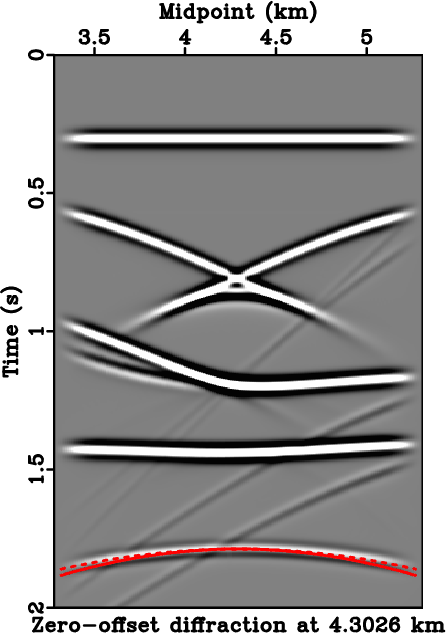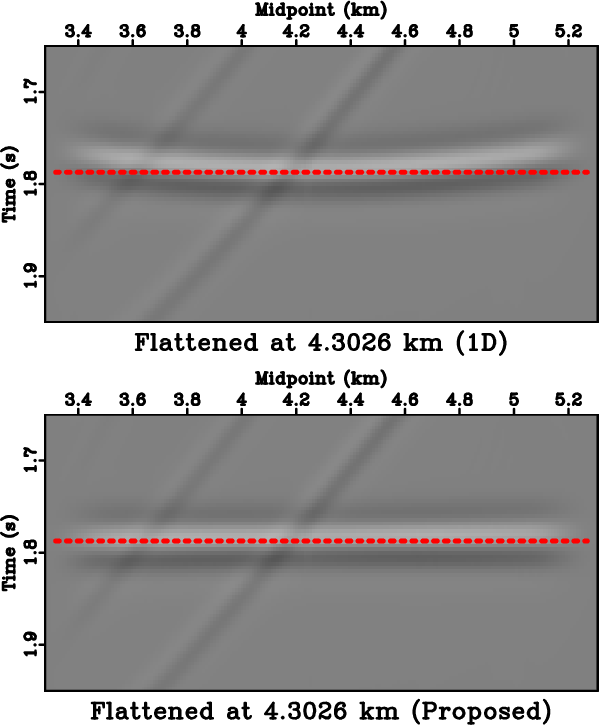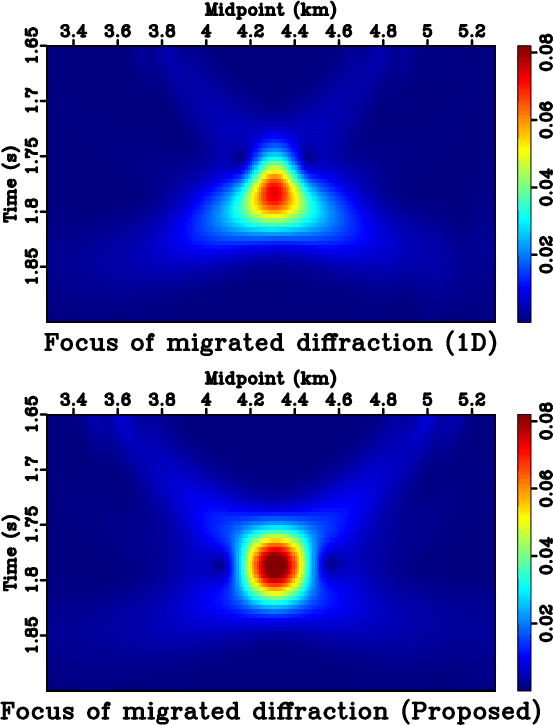|
|
|
|
Effects of lateral heterogeneity on time-domain processing parameters |
Next: Layered isotropic model with Up: Diffraction traveltime in multilayer Previous: Diffraction traveltime in multilayer
We first consider a similar layered anisotropic model. We limit our consideration of the zero-offset section to a small area around 4.3  to ensure the validity of the underlying hyperbolic traveltime approximation for time migration. Figure 9a shows the zero-offset section around the point diffractor before time migration with two hyperbolic summation curves generated with migration velocities from the 1-D assumption and from the proposed method. The flattened diffraction travelime hyperbolas with both velocities are shown in Figure 9b, which indicates a better performance of traveltime prediction from the proposed approach. The results from zero-offset Kirchhoff migration is shown in Figure 10 with the focusing comparison shown in Figure 11. We employ a computation of signal envelope to indicate which diffraction responses is better focused. The higher the value of the envelope magnitude at the center, the better focused the response is. The shape of the envelope pattern also qualitatively indicates the degree of symmetry of the distributed energy. We observe a superior diffraction response with higher focusing and more symmetric envelope from the proposed method.
to ensure the validity of the underlying hyperbolic traveltime approximation for time migration. Figure 9a shows the zero-offset section around the point diffractor before time migration with two hyperbolic summation curves generated with migration velocities from the 1-D assumption and from the proposed method. The flattened diffraction travelime hyperbolas with both velocities are shown in Figure 9b, which indicates a better performance of traveltime prediction from the proposed approach. The results from zero-offset Kirchhoff migration is shown in Figure 10 with the focusing comparison shown in Figure 11. We employ a computation of signal envelope to indicate which diffraction responses is better focused. The higher the value of the envelope magnitude at the center, the better focused the response is. The shape of the envelope pattern also qualitatively indicates the degree of symmetry of the distributed energy. We observe a superior diffraction response with higher focusing and more symmetric envelope from the proposed method.


|
|---|
|
hypercompareanisodiff3,warpedhypercompareaniso3
Figure 9. (a) An example zero-offset section from the layered anisotropic model around 4.3  . The solid lines correspond to regular hyperbolic summation curve based on the assumption of 1-D stratified model, whereas the dashed lines correspond to that from the proposed framework that takes into account the effects from lateral heterogeneity. (b) Flattened diffraction events using the migration velocity with 1-D assumption (top) and the proposed framework (bottom). We can clearly observe improved flatness from using the proposed framework, which indicates a better traveltime prediction and in turn, a more focused migrated response. . The solid lines correspond to regular hyperbolic summation curve based on the assumption of 1-D stratified model, whereas the dashed lines correspond to that from the proposed framework that takes into account the effects from lateral heterogeneity. (b) Flattened diffraction events using the migration velocity with 1-D assumption (top) and the proposed framework (bottom). We can clearly observe improved flatness from using the proposed framework, which indicates a better traveltime prediction and in turn, a more focused migrated response.
|
|
|

|
|---|
|
migcompareaniso
Figure 10. A zero-offset migrated section for the layered anisotropic model. The resultant point diffractor appears to be better focused from the proposed method (right) than from the regular migration velocity based on 1-D assumption (left). |
|
|

|
|---|
|
envcompareaniso
Figure 11. A focusing comparison of migrated point diffractors for the layered anisotropic model. The proposed method leads to a higher magnitude of the focusing at the center and a more symmetric response, which indicates its superior performance. |
|
|